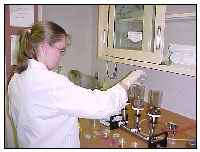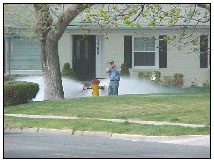|
Bulletin Board
Preparing for Summer Water
Demand
April 17, 2000
During
the spring the trees bud, tulips poke their sprouts through the ground and
Public Utilities employees prepare the water distribution system for the
upcoming high water demand season. With warming temperatures, summer
is not far away.
During the winter months, deep wells are taken out of service and
winterized. April is the month to prepare them to be placed back into
service. Twenty-eight wells have to be taken out of mothballs each
spring and prepared for service. In addition to the wells,
maintenance is performed on the system pump stations. There are over 80
different pumps located within the distribution system. Both the pumps and
electrical motor control centers are checked and exercised.
Elevation change within the water distribution system requires booster
pumps to lift water to the higher elevations of the system. The elevation
change is from 4,200 feet at the valley floor to 5,800 feet above sea
level at the high benches. Dependable water service to the higher zones
requires well-operated and maintained pumping facilities.
Because of Salt Lake
City’s climate and local watering customs, a large volume of water is
consumed for lawn and garden irrigation. Approximately 50 percent of the
annual water delivered into the water distribution system is used for this
purpose. The Salt Lake valley receives about 16-inches of precipitation at
the valley floor with very little of this during the summer months when
tempatures can be expected to reach 100 degrees. This places a large demand
on the system during the summer months. The maximum daily demand is over
200 million gallons per day. Salt Lake City’s maximum day to average day
flow ratio is 2.5, nearly 183 percent higher than most eastern cities
within the United States. In order to meet this wide variation in
demand, large conduits convey treated water from various treatment plants.
Wells strategically located within the distribution system provide
pressure and volume to meet localized water supply demand.
|
Operator Scott Blanton turns a valve to
flush a well in preparation for
operation. | Bob Wallin, Water
Distribution System Manager, has gone through the spring ritual for 20
years. According to Wallin, the spring startup period is important
to successfully provide good service during the high demand period. He
notes, “Thoroughly checking out the equipment is key to dependable water
service when the summer heat turns on.” He adds, “Preventative maintenance
goes a long way towards keeping the equipment going under stress.” The
electricians check the current and voltage under operating conditions and
the pump repair crew checks the mechanical equipment for noises or
vibrations. About 15 employees are assigned to this task during the
spring months.
|
Kim Keller, laboratory microbiologist
conducts bacteria tests to determine if water meets drinking water
standards. | The process of getting
the wells ready for operation includes testing the equipment, flushing the
well for 24 hours and taking bacteriological samples to make sure the
water meets drinking water standards. Once the work is completed and
the bacteriological results have cleared, the well is ready for use. The
distribution operations personnel put the source on the “ready list”
indicating that as demand on the system increases, the well is ready for
service.
Depending on the year, wells provide between 10 and 15 percent of
the annual water supply.
With improving weather conditions, Public Utilities employees start
flushing the distribution system through over 8,000 fire hydrants
connected to the 135 square mile water distribution system within Salt
Lake County. Flushing the system accomplishes two important water
utility functions. First it exercises the fire hydrants, and second it
keeps the water system clean. Flushing dead end mains through flush
valves avoids water quality problems in areas that are not totally
gridded.
|
System flushing ensures that water
quality is maintained in the water distribution system to the
customers tap. | Salt Lake City,
located adjacent to the Wasatch Mountains experiences four distinct
seasons. Spring brings us out of the cold winter months and prepares us
for the hot summer months. Fall completes the seasonal cycle. Public
Utilities operates and maintains its water system according to the
seasons. The hot weather is on its way, and the water system will be ready
to serve our customers.
Questions regarding this can be e-mailed
to: bob.wallin@ci.slc.ut.us
| 




